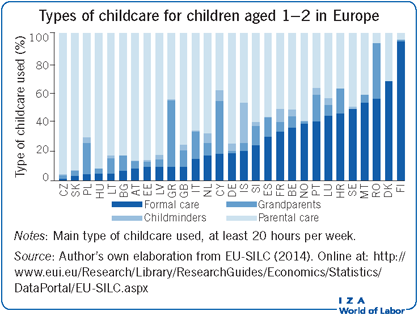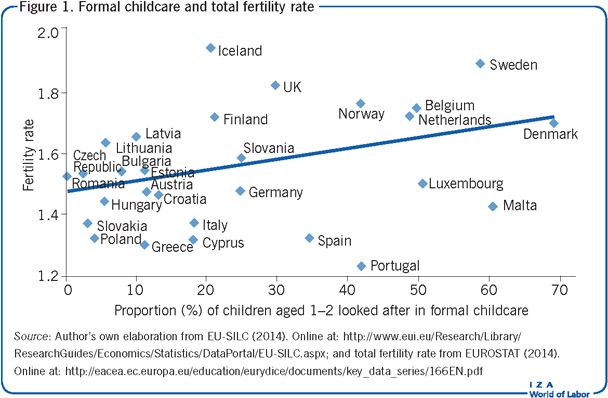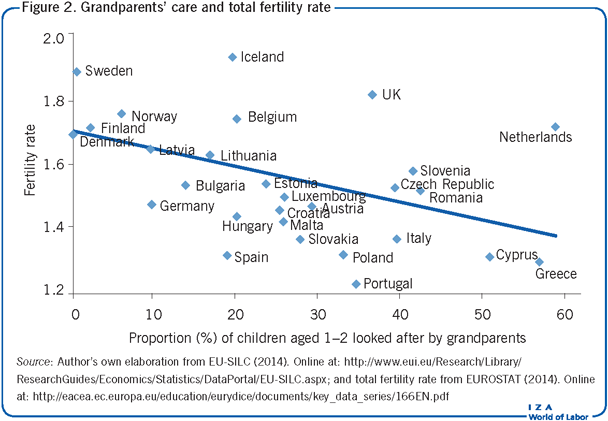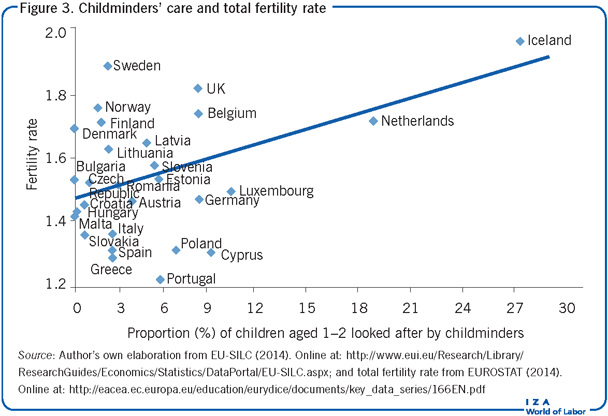Elevator pitch
Increasing population age and low fertility rates, which characterize most modern societies, compromise the balance between people who can participate in the labor market and people who need care. This is a demographic and social issue that is likely to grow in importance for future generations. It is therefore crucial to understand what factors can positively influence fertility decisions. Policies related to the availability and costs of different kinds of childcare (e.g. formal care, grandparents, childminders) should be considered and promoted after an evaluation of their effects on the probability of women having children.

Key findings
Pros
High availability and low costs of formal childcare positively influence families’ decisions to have children.
Having grandparents to help with childcare increases the probability of having children.
The availability of immigrants who work as childminders encourages more-educated women to have more children.
Formal childcare has positive effects on mothers’ working decisions.
Cons
Because access to acceptable childcare can cause women to work more, which may reduce their likelihood of having more children, the net effect of better childcare availability on fertility may be lower than expected.
The provision of childcare for young children is very expensive.
The availability of grandparents to provide childcare may be limited: old grandparents may be sick, young grandparents may still work, and grandparents could have multiple grandchildren from different adult children for whom to care.
Author's main message
The availability of low-cost childcare should reduce the cost of child rearing and therefore have a positive effect on fertility. Indeed, there is empirical evidence that shows a positive link between childcare availability and prices and families’ fertility decisions. However, some types of childcare are accessible only to certain families due to relatively high costs (e.g. childminders or private formal care) or because of family characteristics (e.g. proximity to and age of grandparents). It is therefore important to expand childcare possibilities to all parents via publicly funded childcare.
Motivation
Fertility decisions are taken at the individual/couple level and may be influenced by the social relationships and networks to which individuals belong as well as the prevailing institutional and cultural setting in which they live. Comprehensive availability and/or low cost of childcare should make having children easier for parents, and therefore have a positive effect on the decision to have a child. In examining this topic, it is useful to distinguish among different types of childcare, for instance: care provided by parents, care in formal childcare centers, or care provided by childminders or relatives (especially grandparents). These forms of childcare are characterized by different availability and costs. Formal childcare may be publicly or privately provided, with the differences being related to the required fees and families’ probability of access; professional childminders may be available with higher costs compared to other modes; finally, grandparents may represent a flexible and cheap childcare option, but only if grandparents are in good health, not in employment, and geographically close. Aside from the availability and cost of childcare, other aspects, such as trust (toward institutions, other people, and one’s own family) and the quality of childcare may also influence fertility rates [1].
Discussion of pros and cons
Formal childcare
Several studies have considered the relationship between formal childcare and fertility. Despite the intuitive hypothesis of a positive relationship between the two, the empirical evidence remains quite mixed (see Figure 1). This is due to a lack of adequate data and the use of unsatisfactory methods. Most empirical research is based on survey questions about women’s perception of constraints to childrearing related to lack of formal childcare as well as on information about the local availability and costs of formal childcare. Unfortunately, more methodologically robust information about the availability of formal childcare and prices over time is less frequent. There is also substantial variation between the US and European studies. In the US, formal childcare is typically private, with most research and debate addressing prices and quality. In Europe, by contrast, formal childcare is mainly public and the debate addresses its availability (rationing of the service versus universal provision). Moreover, within the EU, there is substantial variation in childcare use across countries (see Illustration). For instance, in the Czech Republic less than 2% of children aged 1–2 are looked after in formal childcare centers for at least 20 hours per week; the corresponding number in Finland is more than 90% according to data from the 2014 EU Statistics on Income and Living Conditions (EU-SILC). The non-universalism of formal childcare in many countries is related to the high costs of maintaining small class sizes (i.e. few children per teacher/caretaker).

Some of the first US studies on the topic are based on women’s perception of constraints due to lack of formal childcare. The findings suggest that expected fertility is lower among mothers who report lack of childcare, there is a positive relationship between respondents’ current childcare and future childbearing intentions (i.e. higher quality current childcare leads to families having more children in the future), and respondents’ plan to have fewer children due to a lack of satisfactory childcare [2].
The most common strand of studies examines the relationship between fertility and the local availability of childcare (in the EU) or childcare prices (in the US), taking into account mothers’ work decisions. Notwithstanding the diversity of EU countries, a positive correlation is generally found between public childcare coverage and the probability of having a child. However, in most cases, the positive influence only concerns second or third children [3], [4], [5].
Information on childcare characteristics is usually collected through surveys and aggregated to build average indicators at the local level [6]. A handful of studies have considered the effects of childcare costs on both employment and fertility outcomes using US data. These studies provide results suggesting that lower childcare costs increase fertility. Results are obtained by comparing how transitions between employment (including job-to-job as well as moving in and out of employment) and fertility rates respond to geographic variation in weekly childcare expenditures, and how variation in the individual-level association between fertility and labor market participation is explained by conditions in the local childcare market.
Given that childcare is typically private in the US, prices and availability are determined by parental demand and market supply and therefore influenced by internal factors (endogenous). In this sense, the US studies have drawbacks. Similarly, in the European context, where childcare is provided by the public system, the assumption that coverage is influenced by external factors (exogenous) is questionable. Unobserved local factors that affect fertility decisions are also likely to affect the local availability of childcare, leading to an overestimation of the true effect.
These limitations can be overcome when researchers have access to data on the geographical availability of childcare over time. This allows one to consider local characteristics, which do not vary over time, that can affect both childcare availability and fertility (e.g. cultural factors, employability of women, preferences to have large families). Following this strategy, a strong positive effect of childcare availability has been found in Norway [7], and a positive effect of lowering prices has been found in Sweden [8]. Increasing formal childcare coverage by 25 percentage points increases the probability that a (Norwegian) woman aged 25–29 will have a first child by around 1 percentage point; for example, going from 50% to 75% of coverage is expected to increase the probability from 11.3% to 12.3%. With respect to prices, the Swedish study found that a €10,000 reduction in future childcare costs (in present value) increases fertility by around 10%. These types of results are achievable because Nordic countries have very good data at their disposal: the availability of register data for the whole population over time allows researchers to analyze large samples and not lose precision when using more sophisticated analytical strategies [7], [8].
Grandparents
The availability of grandparents willing to care for grandchildren should decrease the cost of child rearing and therefore have a positive effect on fertility. However, different aspects need to be considered, such as grandparents’ age and health. Sick or frail grandparents may be willing to help with childcare, but might not be considered reliable enough by parents. Younger grandparents may be less available because they are still at work. Finally, the role that grandparents take in childcare may vary according to a society’s welfare system and culture. Grandparents seem to be more important in those countries where state-provided welfare is weak. For example, according to EU-SILC data the percentage of very young children (1–2 years old) in Europe who are looked after by their grandparents for at least 20 hours per week ranges from less than 1% in Nordic countries (Denmark, Finland, Norway, Sweden—where welfare systems are strong) to more than 30% in countries like Greece, Cyprus, and Romania, where welfare systems are not robust. As seen in Figure 2, countries with a high percentage of grandparents helping in childcare are typically those with lower fertility rates.

Most studies that address this topic focus on the impact of grandparents’ care on mothers’ work decisions, and typically find a positive relationship [9]. On the other hand, only a few studies have considered the impact of grandparents’ care on fertility behavior directly. In Italy, a country characterized by low fertility and low availability of formal childcare, a positive effect of having at least one grandparent alive has been found on both the probability that a woman works and that she gives birth [4]. However, the actual amount of childcare provided by grandparents is not observed, and the only variation in the childcare variable is represented by the death of the last grandparent. A study of west German women that considers the presence or absence of grandparents living in the same town suggests that access to informal care arrangements increases the probability of having a first child [5]. Among employed US women, having an additional adult in the household other than the husband increases the probability of having a child [6]. US women who rely on grandparents as opposed to paid formal childcare are more likely to have an additional child [10]. Using a three-generation sample of Dutch individuals and comparing grandparents’ care with birth of children over a period of eight years, it has been observed that those receiving grandparents’ help in childcare have more children than those that do not [11].
Moreover, the extent to which grandparents can help care for grandchildren depends on the grandparents’ past fertility behavior. In other words, if grandparents have multiple children, who then have multiple children of their own, then the grandparents’ availability to provide childcare may be reduced across the group of grandchildren. This implies that the more siblings a parent has (and the more children each sibling has), the lower the chances that an adult child will receive childcare help from their children’s grandparents. One study does find that an adult child is more likely to have another child if his/her sibling receives childcare help from the grandparents; but this is true only when the grandchild being looked after is older than three. In contrast, adult children are less likely to have another child when grandparents look after a sibling’s child who is younger than three [12].
However, it should be noted that the above studies do not fully address one important endogeneity problem: the use of grandparents’ care is decided within the family and not determined exogenously. An exception is represented by pension reforms, which can change the supply of grandparents despite their work/family preferences. One study exploits increases in legal retirement ages in Italy; potential grandmothers are observed to work more and provide less childcare, but their adult daughters are more likely to have children. This counterintuitive result is probably an effect resulting from an increase in income due to later retirement [13].
Childminders
There is less research on the effect of childminders’ availability and costs on fertility decisions than for other modes of childcare. One reason is that the percentage of young children looked after mainly by childminders is relatively small, given that few families can afford to pay the full wage of a person to look after their child. In most countries, less than 5% of children are looked after primarily by childminders. One exception is Iceland, where, as EU-SILC data show, the percentage equals 25%. Despite the relatively low levels of childminder care, a positive association between childminders’ diffusion and fertility rates at the country level can be observed, as shown in Figure 3.

A second reason for the lack of empirical evidence on childminders is a lack of data on their labor supply and salaries. One exception is found in the immigration literature because a large share of childminders are immigrants. While there is much concern about the potentially negative impact of immigration on natives’ employment, less attention has been paid to the potential benefits of immigration on native women’s labor market participation and fertility. However, simply relating the presence of immigrants to women’s fertility and work decisions might not reveal a causal relationship if immigrants are more likely to reside in places where women already work more (in more developed regions, for example) or in areas with typically large families. To address this concern, researchers exploit the fact that new immigrants are more likely to live in areas with high historical concentrations of immigrants from the same country of origin, and show that there is indeed a positive effect of new flows of immigrants on both fertility and work of native women. Given that childminders usually cost considerably more than formal childcare, these effects generally concern highly educated women.
Limitations and gaps
In general, most of the reviewed studies are limited by a lack of adequate data and because they use methods that cannot establish causal relationships between childcare and fertility. Studies looking at the relationship between the use of external childcare and fertility cannot be established as causal because women who use external childcare may have other unobservable characteristics that also affect the decision of having a child. For example, women who are more trustful, in general, may have more positive attitudes toward externalizing childcare, and toward having more children. In studies exploiting the local availability of external childcare, the reason for which there is more external childcare in a given region can be related to the respective families’ preferences. In studies looking at the effect of grandparents’ availability to provide childcare, the endogeneity problem could be quite severe. First, families who can and do choose grandparents as their main childcare option may be rather different from other families in terms of family decisions. Second, from a methodological point of view, the use of grandparents’ childcare is not determined outside the family (e.g. as with public childcare or immigrant flows).
Another consideration related to the women’s work dimension is that women who are more likely to change their fertility intentions in response to childcare availability are probably those who want to work. One may expect stronger impacts on fertility from the availability of (low-cost) childcare in two (almost opposite) cases: for women who are more career-oriented, as well as for women who need more income. Further empirical research may shed some light on these diverse effects.
The most robust evidence available comes from studies that exploit data on the availability of external childcare over time, thus allowing for the consideration of local characteristics that do not vary over time, as well as from studies where childcare availability may be predicted using instrumental variables (a methodological approach to address endogeneity issues) [7], [8], [13]. However, for the correct determination of causal effects, large sample sizes are required to produce precise estimations and to allow for the study of heterogeneous effects across different subsamples of the population; such large samples are rare in practice.
Summary and policy advice
Theoretical models predict that a larger availability of childcare and reductions in childcare costs should affect both the labor supply of mothers and the fertility of couples. By lowering the cost of having children, the demand for children should, theoretically, increase. However, the effect of childcare on fertility is likely to depend on the mother’s labor supply decision (i.e. does the mother wish to work more or have more children), so that the link between childcare and fertility remains an empirical issue. A number of empirical studies look at the relationship between different modes of childcare (formal childcare, childminders, grandparents) and fertility decisions. There is evidence of a positive impact of childcare availability (regional public childcare coverage, regional availability of childminders, grandparents’ proximity) on the probability of having children.
To answer the question of what types of childcare should be promoted in order to increase fertility, it is necessary to account for the costs and benefits of each childcare mode for different kinds of families. While grandparents’ care is the cheapest option, it is not available to each family. In some countries, like Italy and Germany, policymakers have actively encouraged grandparents’ care as the main means of childcare. However, this type of policy, if not accompanied by other measures, cannot be very effective. First, grandparents (probably grandmothers) need to be retired to provide primary childcare, which stands in contrast to many new reforms aimed at increasing the retirement age in most European countries. Second, because grandparents’ care may be less available when grandparents have multiple grandchildren from more than one adult child, this form of childcare may thus be more effective in countries where families are typically smaller, i.e. in countries with low current (and future) fertility.
Public subsidies for employing childminders may be another option to consider, but this would likely only be relevant for relatively wealthy families, as childminding is an inherently expensive form of childcare. It is therefore important that all families have access to publicly funded formal childcare. An obvious drawback to this is that formal childcare costs are high for governments because of high staff-to-children ratios. This is particularly true when providing childcare for very young children. However, as shown in the case of Norway, increasing public childcare coverage can have a direct impact on the likelihood of women having a first child. Considering that 40% of women in Europe aged 21–45 are currently childless, this option should not be ignored. In balancing the costs and benefits of childcare provision, policymakers should not forget to consider the additional potential positive impact on mothers’ labor supply.
Acknowledgments
The author thanks an anonymous referee and the IZA World of Labor editors for many helpful suggestions on earlier drafts. The author would also like to thank Silvia Labriola for excellent research assistance.
Competing interests
The IZA World of Labor project is committed to the IZA Guiding Principles of Research Integrity. The author declares to have observed these principles.
© Chiara Pronzato